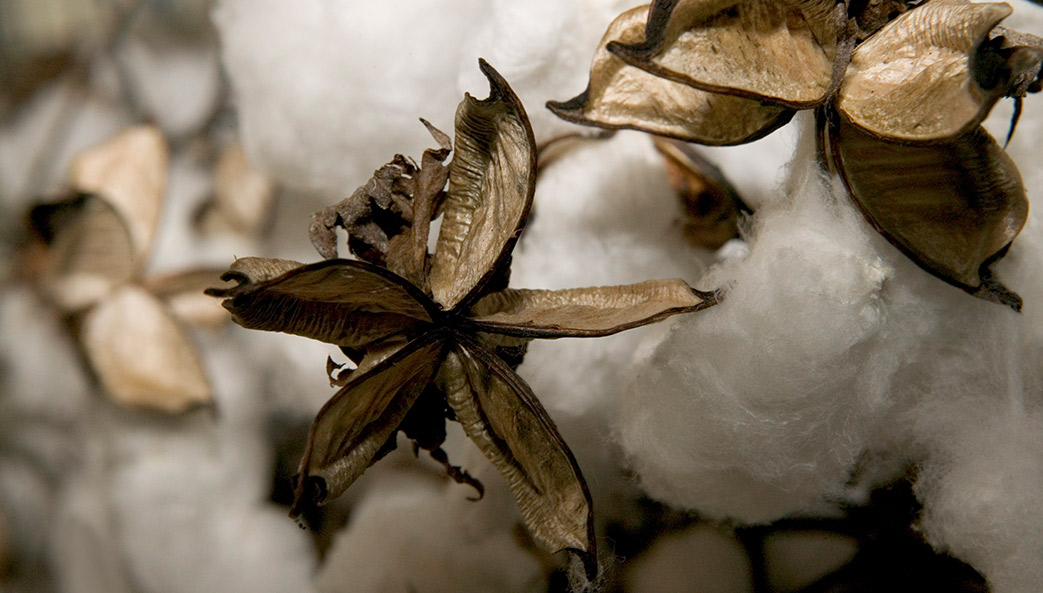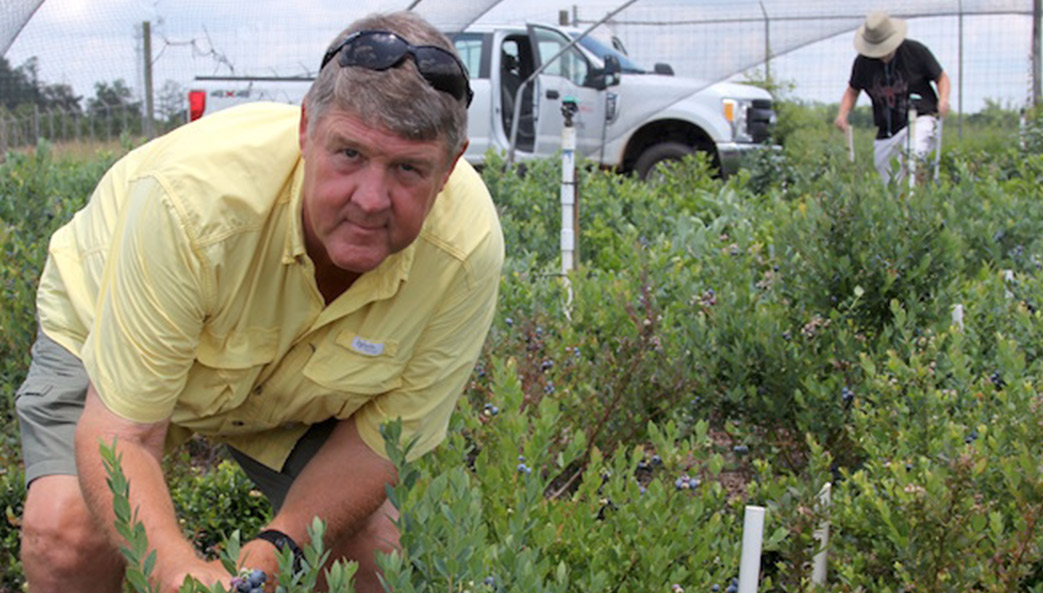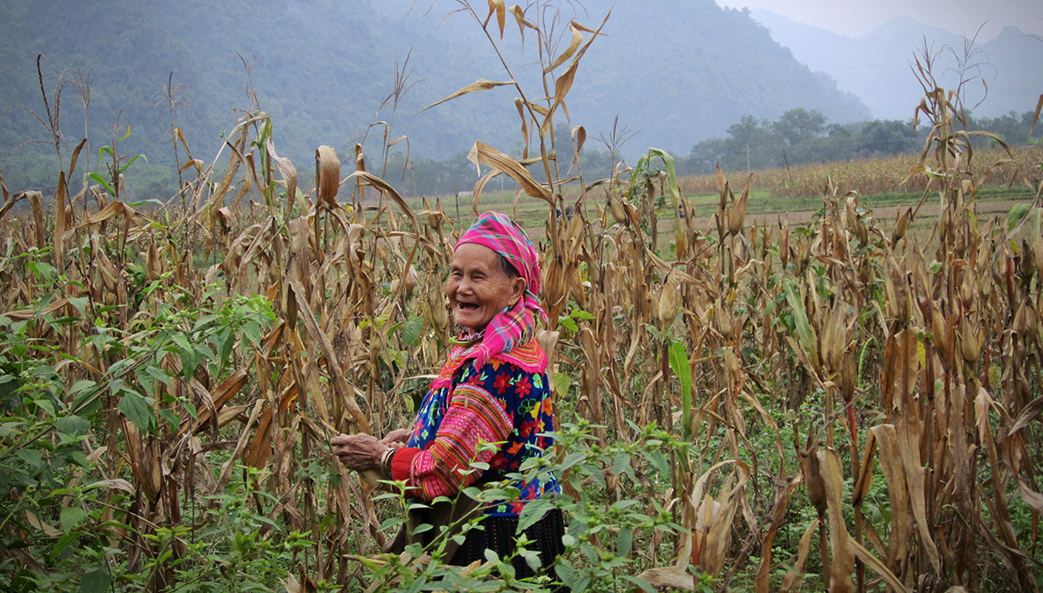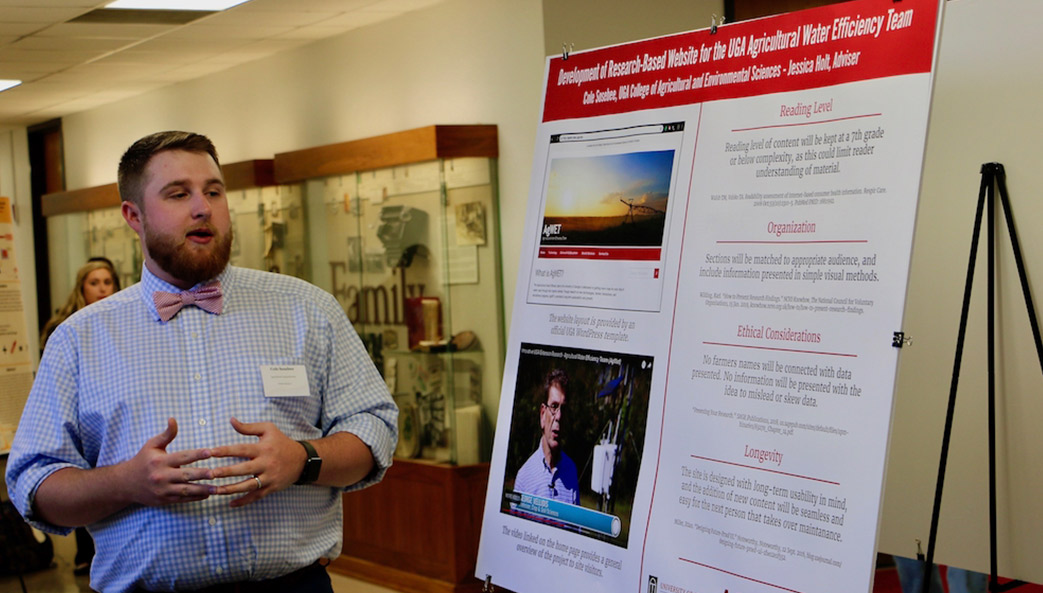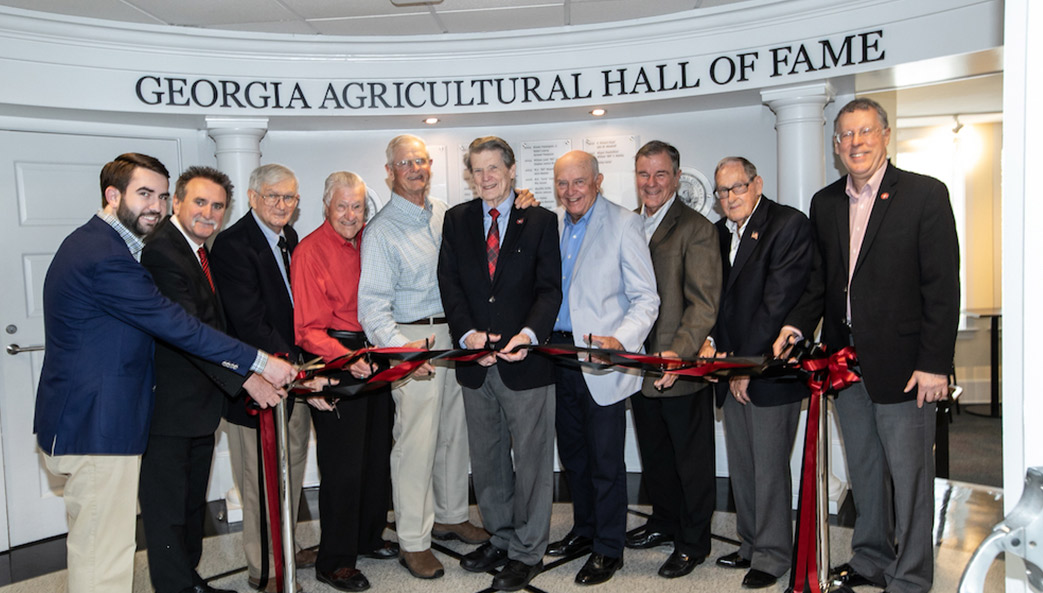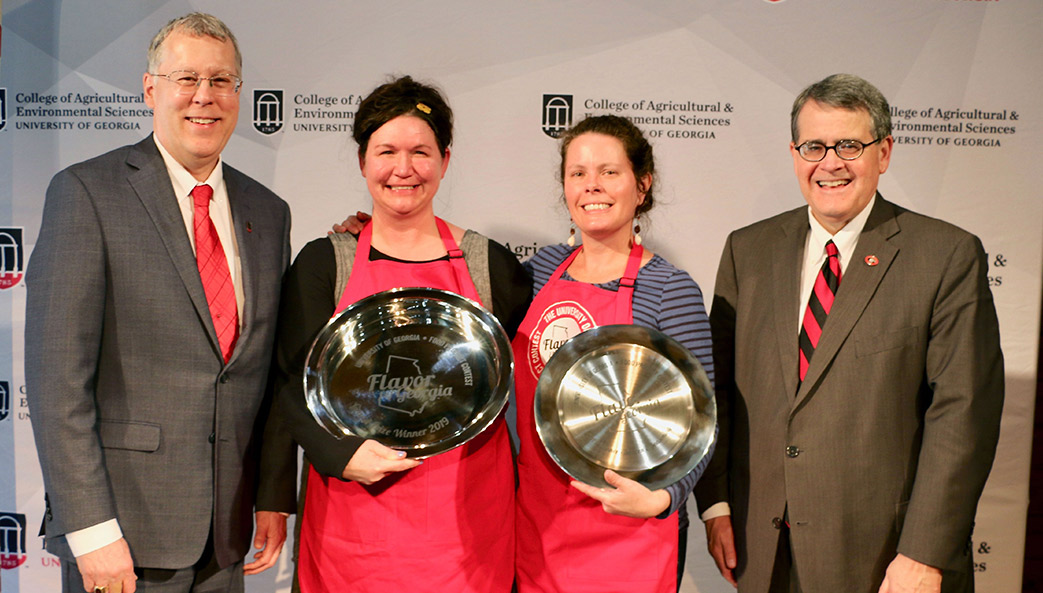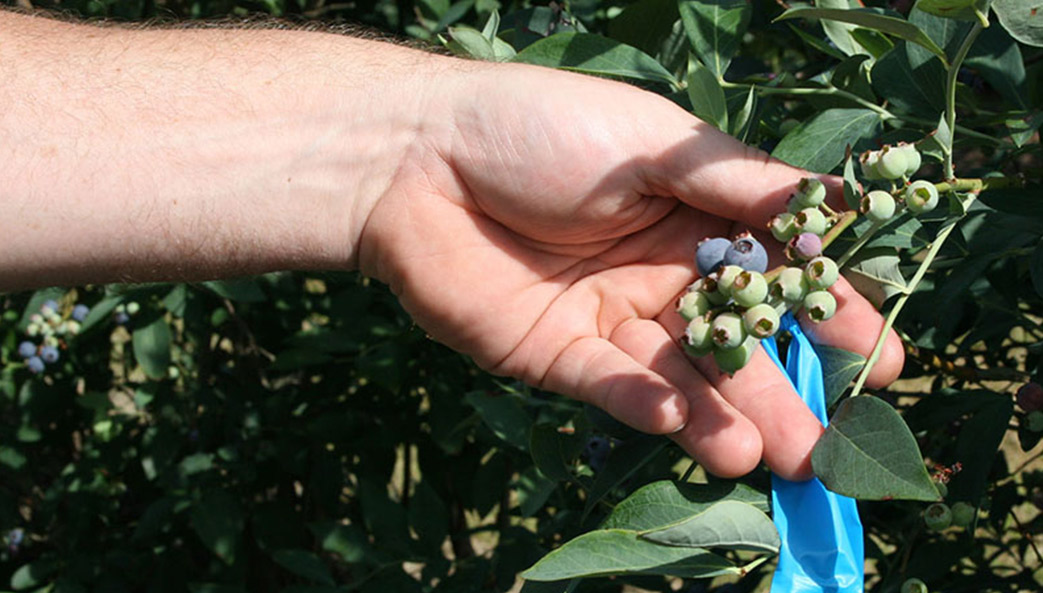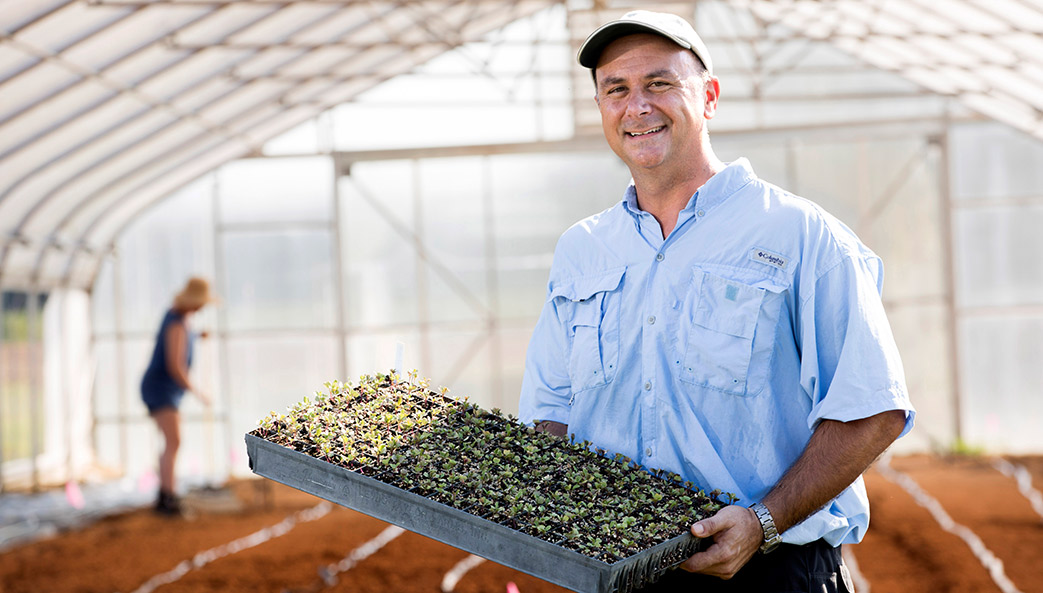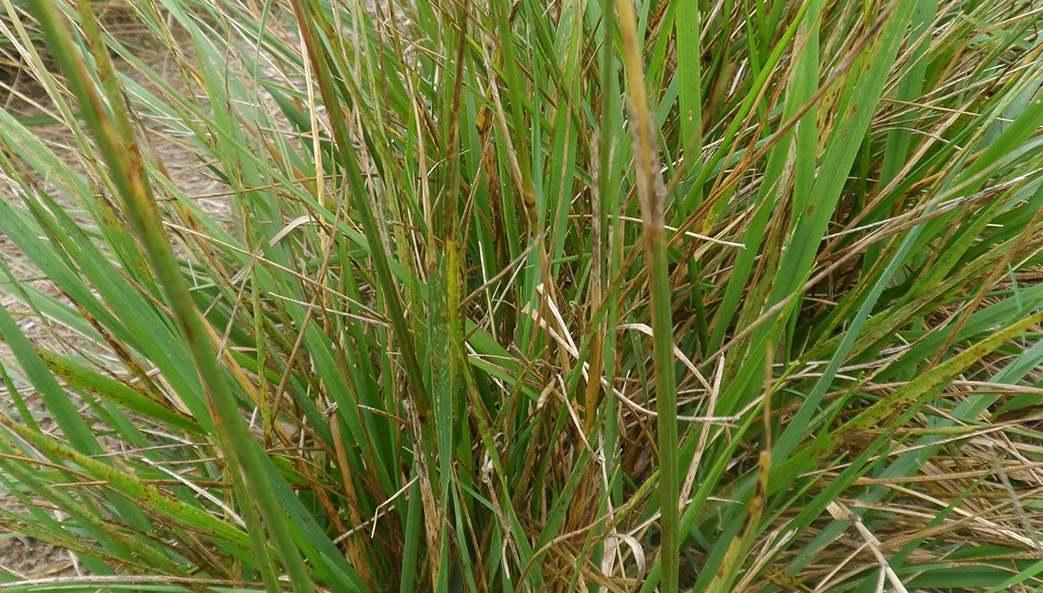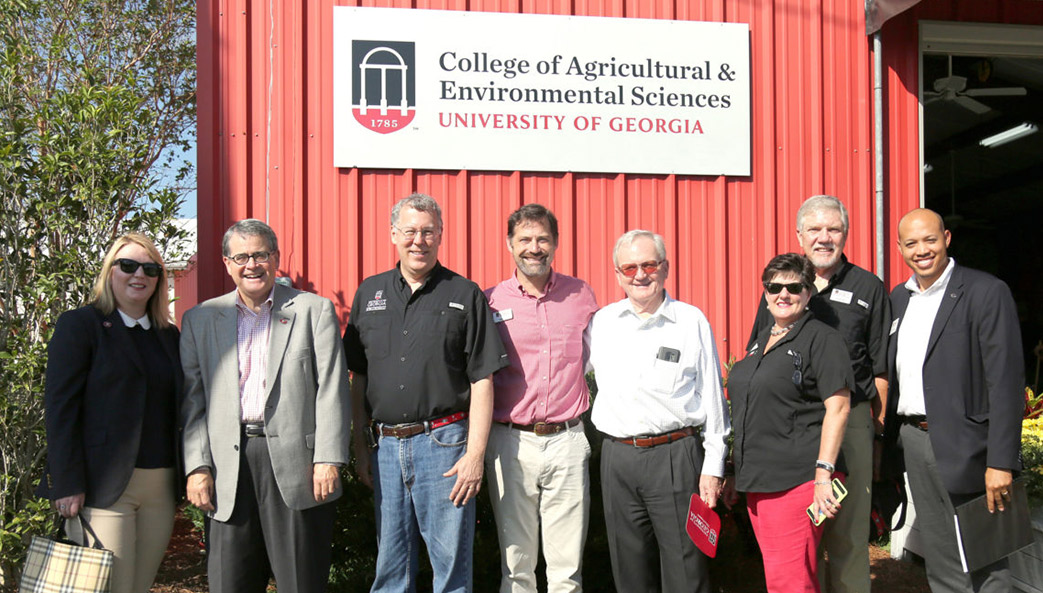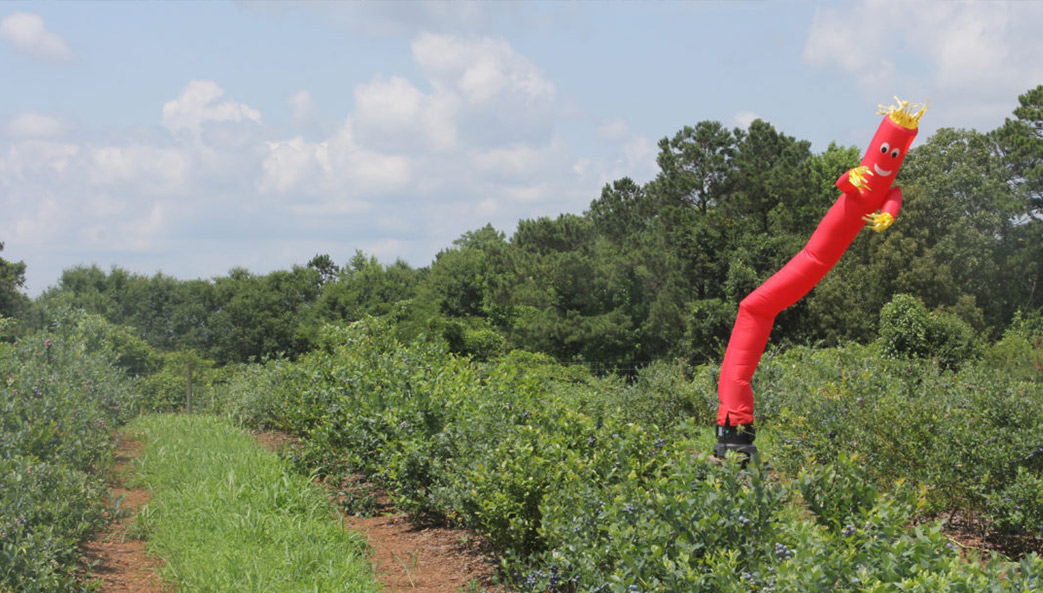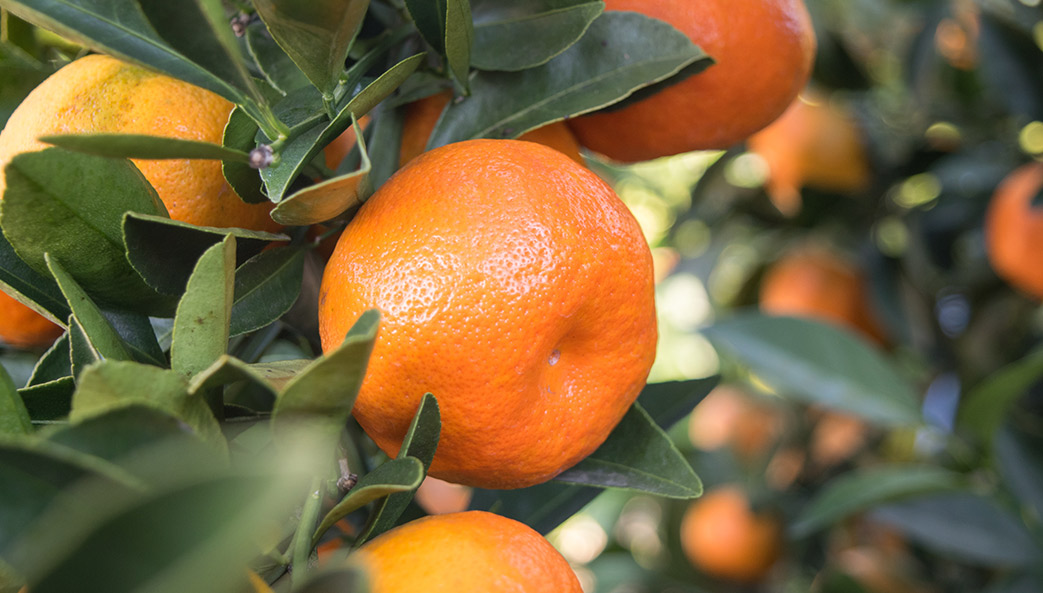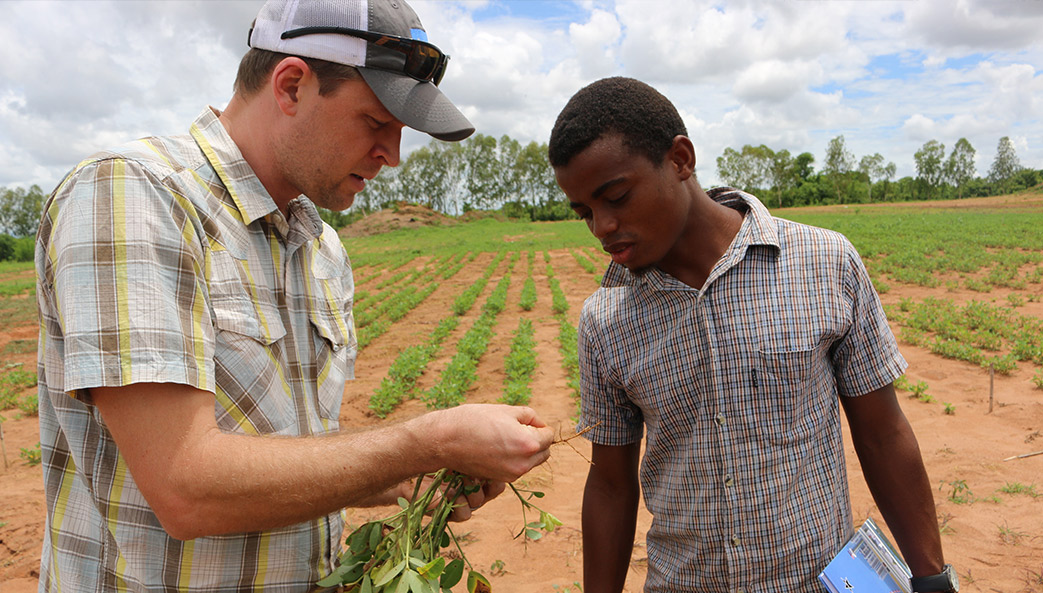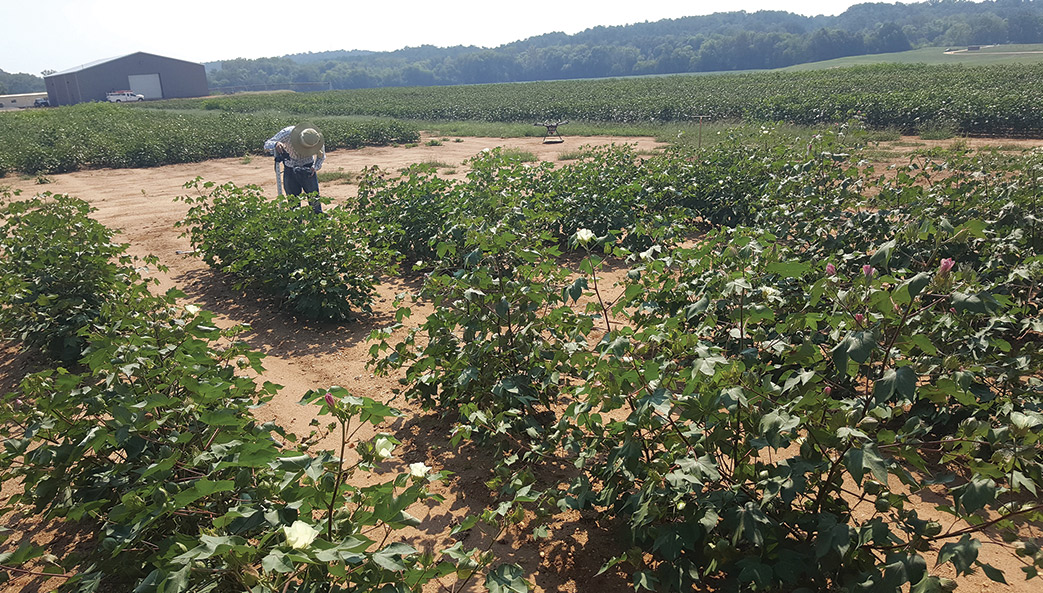Summer open houses highlight sustainable agriculture research at UGA
Northeast Georgians will get a sneak peek at the future of farming
On its centennial, UGA-Tifton reflects but looks forward
Speakers at the UGA-Tifton centennial celebration included, from left, Scott Angle, director of USDA NIFA; Sam Pardue, UGA CAES dean; Jere W. Morehead, UGA president; Gary Black, Georgia agriculture commissioner; Joe West, UGA-Tifton assistant dean; U.S. Rep. Austin Scott; and Archie Tucker, USDA southeast area director.
By Clint Thompson
For 100 years, the University of Georgia Tifton campus has been committed to agricultural research that benefits the state of Georgia and the world. As the campus turns the page to its next century, UGA-Tifton is focused on cultivating the next generation of agricultural leaders who will help feed and clothe a growing population.
On May 3, UGA-Tifton held a centennial celebration that was as much a time of hope and excitement in looking to the future as it was a day of reflection on the campus’s past accomplishments.
“Agriculture is Georgia’s No. 1 industry, and the UGA Tifton campus has played a vital role in helping our farmers build this industry and sustain its success,” said President Jere W. Morehead. “I am confident that the positive impact of our faculty, staff and students at UGA-Tifton will be even greater over the next 100 years.”
A part of highlighting the campus’s future was a research poster competition of the work being done by undergraduate, graduate and postdoctoral students at UGA-Tifton in the College of Agricultural and Environmental Sciences. Students shared their individual projects and met with UGA administrators and industry leaders.
“Since the first class of students graduated from UGA-Tifton in 2004, we have seen some of the brightest scholars in the region grow and explore the science of agriculture on our Tifton campus,” said CAES Dean Sam Pardue. “These students have a tremendous opportunity to earn a UGA degree close to home while working alongside some of the very best agricultural scientists in the world. After seeing their presentations, we are all assured the future of the industry is in good hands.”

Pardue spoke about his vision for the future, which includes the continued success of the campus in helping to maintain agriculture as the top industry in Georgia.
“Cutting-edge science has been our tradition in the College of Agricultural and Environmental Sciences for more than a century. Our scientists are ready to lead the way to the great discoveries ahead,” Pardue said.
“We will move forward from the days of creating the first mechanical peanut combine to developing new precision agriculture tools, such as robotic technology that can harvest a whole host of crops. We will use what we have learned from generations of irrigation research to ensure we have the technology at our fingertips to conserve and protect our essential water resources in the future while improving crop productivity. We will explore vast opportunities in the newest areas of agricultural science, including the role of the microbiome, genetics and genomics, controlled-environment farming and other new technologies that will make us better scientists, better teachers and better stewards of agriculture,” Pardue added.
Originally known as the Coastal Plain Experiment Station, UGA-Tifton has been home to world-renowned scientists such as National Medal of Science award winner Glenn Burton; peanut scientist Frank McGill, whose package approach to peanut production increased peanut yields in Georgia; turfgrass pioneer Wayne Hanna, who produced cultivars that are grown throughout the world; and peanut researcher Peggy Ozias-Akins, who helped map the peanut genome.
It’s just a beginning
“This day of celebration is an opportunity to look in the rearview mirror and see what’s happened on our campus, but as scientists, we always have to be looking forward,” said UGA-Tifton Assistant Dean Joe West. “May 3 is not an end; it really is a beginning.”
Part of the day’s festivities also included the dedication of the Centennial Garden, located behind the Tift Building in the center of campus. The 2-acre garden is a re-creation of a garden that existed in an earlier era. It contains 100% UGA-generated genetic plant releases.
In collaboration with the U.S. Department of Agriculture’s Agricultural Research Service, UGA-Tifton is host to more than 400 employees, including scientists focused on various research projects dealing with crops, insects and plant diseases. The campus covers more than 5,000 acres in South Georgia. UGA-Tifton research projects also are conducted on farms and research and education centers throughout the state in Attapulgus, Camilla, Midville and Plains.
Say “fromage”
Winners of the Agriculture Abroad Photo Contest were chosen April 17 at the International Agriculture Day celebration, sponsored by UGA’s College of Agricultural and Environmental Sciences. The contest showcases photographs taken by students on an academic or personal trip that exemplify their perceptions of agriculture outside the United States.
Dung Tran, a doctoral student in the CAES Institute of Plant Breeding, Genetics and Genomics, won first place with her photo “Happy H’Mong Farmer in the Corn Field.” Tran, who worked in plant conservation in Vietnam, took the photo on a seed collecting trip.
Each family in this region of the country grows their own heirloom corn variety, Tran said. The farmer in the photo took Tran into her family’s field to collect seeds from her family’s variety of sticky corn.
Other students recognized in the photo contest were Sujata Bogati, a master’s student in the Department of Crop and Soil Sciences, with her second-place photo “Agriculture in the Mountain Regions,” and Lauren Rutledge, an undergraduate student in the Department of Animal and Dairy Science, with her third-place photo “Cacao? More like CaWOW!”
Rounding out the top five were Amanda Olbrick Marabesi, a master’s student in Agricultural and Environmental Education, with “You Reap What You Sow,” and Kendall Sewell, an undergraduate student in Environmental Economics and Management, with “Return to the Valley.” Entries were judged by faculty, staff, students and guests at CAES International Agriculture Day.
Americans buy food knowing some will be wasted, UGA study shows
One-third of the food supply in the U.S. goes unconsumed
Americans buy food knowing some will be wasted, UGA study shows
One-third of the food supply in the U.S. goes unconsumed
Entomologists uncover Florida fire ant matriarchy
Tropical fire ants native to Florida and coastal Georgia thrive with multiple queens
Student researchers shine at annual CAES Undergraduate Research Symposium
CAES students get opportunity to communicate their research findings
Georgia Agricultural Hall of Fame renovation celebrates legacy and future of agriculture
The UGA College of Agricultural and Environmental Sciences Alumni Association has housed the Georgia Agricultural Hall of Fame since 1972
Farm gate value of Georgia crops collected by UGA economists, county agents
The agents interact daily with their farmers and this allows them to get a good feel for what is happening in their counties.
There’s fertile ground for organic agriculture education
The intersection of increased consumer interest and new technology and research makes it a good time for horticulture students to focus on vegetable production.
Grant to help researchers study how plants interact with their microbiomes
UGA researchers are working to understand thIs interaction to breed more sustainable crops.
New truffle species named after UGA’s Tim Brenneman
At least three known truffle species are found in Georgia, and all grow in pecan orchards
UGA economists estimate up to $600 million in cotton damage from Hurricane Michael
Only 12 percent of Georgia’s cotton crop had been harvested prior to the storm’s arrival
Georgia farmers face more than $2 billion in losses from Hurricane Michael
Cotton agronomist: “It’s much worse than I thought it would be.”
Farmers, leaders, UGA president gather for Sunbelt Expo
The South Georgia agricultural damage from Hurricane Michael was a top topic
Farm Tour highlights diversity of agriculture industry
President Morehead and Georgia officials learn firsthand about state’s No. 1 industry
Collecting raspberry and peach seeds from Down Under
Researchers will use the seeds to breed new varieties for Georgia and the Southeast
UGA and USAID launch new partnership to fight hunger with peanuts
$14 million grant will help researchers develop new varieties and focus on pre- and postharvest management
UGA and USAID launch new partnership to fight hunger with peanuts
$14 million grant will help researchers develop new varieties and focus on pre- and postharvest management
Scientists help farmers fight late freezes
Atmospheric scientists develop a set of equations to aid farmers who use irrigation for frost protection predict the best time to turn on their systems.
Turning tea into a Southern commercial crop
Photography by Amy Ware
Sweet tea may be the “house wine” of the American South, but very few of the tea leaves used in the thousands of gallons of tea Southerners drink every year are grown nearby.
Despite Southern experiments in tea farming dating back to Colonial times, this temperamental cousin of the camellia has never caught on as a cash crop. However, with growing interest in craft teas and innovations in breeding and harvesting technologies at hand, it may be time for the South to start supplying its families’ pitchers with locally grown tea.
“Tea has been grown here, but for some reason—the cost of processing, the cost of cultivation, the cost of labor—it’s never become a large-scale crop,” said Donglin Zhang, a professor of horticulture at UGA’s College of Agricultural and Environmental Sciences. Zhang is working to bring large-scale production of tea—Camellia sinensis (L.) Kuntze—to the U.S.

Today, tea harvesting has been mechanized, and the demand for tea has grown. U.S. sales grew from $1.8 billion in 1990 to $10.8 billion in 2014, according to the Tea Association of the USA. That market trend, combined with consumers’ growing preference for locally sourced products, may mean that it’s finally tea time in the South.
Right now, there’s only one large-scale commercial tea farm in the continental U.S.—the Charleston Tea Plantation outside of Charleston, South Carolina—though there are artisan growers and smaller farms in more than a dozen states. The Great Mississippi Tea Company opened recently in Brookhaven, Mississippi, and Zhang expects that more farms will be established in the near future.
“Consumption has gone up, prices have gone up and mechanical harvesting techniques have improved,” Zhang said. “This is why I think it could work here.”
Zhang has extensive experience as an ornamental plant breeder and was first drawn to tea and Camellia species as ornamental plants. His breeding program focuses on producing plants that serve two purposes: food and beauty.
“People today have smaller yards, and I think there is interest in plants that have multiple purposes,” he said.
He has traveled to China to collect varieties of persimmon, jujube and waxberry to use as parent plants for ornamentals that could thrive in the Georgia environment.
With delicate foliage, variegated leaves, bright blooms in the form of camellia flowers and the prospect of a homegrown cuppa, tea plants are also part of his ornamental breeding program.
Then he thought, “If tea plants could be successfully grown in a yard, why couldn’t they grow on farms?”
Many of the tea plants grown for beverage production are notoriously cold-sensitive and don’t tolerate the rapid temperature changes common in Georgia. Zhang is working to breed more cold-tolerant plants that also produce a distinctly delicious Southern tea.
Today, Zhang has a selection of nine tea cultivars growing at the Durham Horticulture Farm outside UGA’s Athens campus. During a recent trip to China, Zhang and plant breeders from other Southeastern land-grant universities identified several dozen varieties out of the 4,000 currently being grown there commercially that they believe will flourish in Georgia and throughout the South. Zhang hopes to add those varieties to his breeding program in the future.
This story appeared in the fall 2017 issue of Research Magazine. The original press release is available at http://www.caes.uga.edu/news/story.html?storyid=6094&story=Hometown-Tea.
Turning tea into a Southern commercial crop
Photography by Amy Ware
Sweet tea may be the “house wine” of the American South, but very few of the tea leaves used in the thousands of gallons of tea Southerners drink every year are grown nearby.
Despite Southern experiments in tea farming dating back to Colonial times, this temperamental cousin of the camellia has never caught on as a cash crop. However, with growing interest in craft teas and innovations in breeding and harvesting technologies at hand, it may be time for the South to start supplying its families’ pitchers with locally grown tea.
“Tea has been grown here, but for some reason—the cost of processing, the cost of cultivation, the cost of labor—it’s never become a large-scale crop,” said Donglin Zhang, a professor of horticulture at UGA’s College of Agricultural and Environmental Sciences. Zhang is working to bring large-scale production of tea—Camellia sinensis (L.) Kuntze—to the U.S.

Today, tea harvesting has been mechanized, and the demand for tea has grown. U.S. sales grew from $1.8 billion in 1990 to $10.8 billion in 2014, according to the Tea Association of the USA. That market trend, combined with consumers’ growing preference for locally sourced products, may mean that it’s finally tea time in the South.
Right now, there’s only one large-scale commercial tea farm in the continental U.S.—the Charleston Tea Plantation outside of Charleston, South Carolina—though there are artisan growers and smaller farms in more than a dozen states. The Great Mississippi Tea Company opened recently in Brookhaven, Mississippi, and Zhang expects that more farms will be established in the near future.
“Consumption has gone up, prices have gone up and mechanical harvesting techniques have improved,” Zhang said. “This is why I think it could work here.”
Zhang has extensive experience as an ornamental plant breeder and was first drawn to tea and Camellia species as ornamental plants. His breeding program focuses on producing plants that serve two purposes: food and beauty.
“People today have smaller yards, and I think there is interest in plants that have multiple purposes,” he said.
He has traveled to China to collect varieties of persimmon, jujube and waxberry to use as parent plants for ornamentals that could thrive in the Georgia environment.
With delicate foliage, variegated leaves, bright blooms in the form of camellia flowers and the prospect of a homegrown cuppa, tea plants are also part of his ornamental breeding program.
Then he thought, “If tea plants could be successfully grown in a yard, why couldn’t they grow on farms?”
Many of the tea plants grown for beverage production are notoriously cold-sensitive and don’t tolerate the rapid temperature changes common in Georgia. Zhang is working to breed more cold-tolerant plants that also produce a distinctly delicious Southern tea.
Today, Zhang has a selection of nine tea cultivars growing at the Durham Horticulture Farm outside UGA’s Athens campus. During a recent trip to China, Zhang and plant breeders from other Southeastern land-grant universities identified several dozen varieties out of the 4,000 currently being grown there commercially that they believe will flourish in Georgia and throughout the South. Zhang hopes to add those varieties to his breeding program in the future.
This story appeared in the fall 2017 issue of Research Magazine. The original press release is available at http://www.caes.uga.edu/news/story.html?storyid=6094&story=Hometown-Tea.
Enhancing sorghum’s drought resiliency
Research project is aimed at creating varieties of sorghum that can survive extreme drought and appeal to those who eat the cereal as part of their traditional diet.

